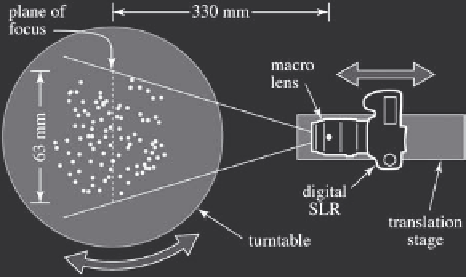Graphics Reference
In-Depth Information
Figure 8.68
Measurement setup for capturing hair geometry. (From [Jakob et al. 09] c
2009 ACM,
Inc. Included here by permission.)
Moon, and Steve Marschner [Jakob et al. 09]. In this paper, the authors point out
that the local structure of hair strongly affects its appearance, but the existing hair
modeling methods did not accurately reproduce such local structure. The typical
method for generating detail in hair geometry was to randomly perturb the local
arrangement of hair fibers in an ad hoc fashion. For example, guide curves can
be created for the general structure of the particular hair arrangement, with indi-
vidual fibers added along the curve offset by a small random amount. However,
Jakob and his coauthors realized that in order to model the structure of hair, it was
necessary to understand how real hair fibers are arranged. The paper thus begins
by describing a method for precisely capturing the geometric details of real hair.
Capturing the small-scale structure of a lock of hair depends on the ability
to reliably distinguish the individual hairs. The authors devised a method to do
this using captured images from a set of viewpoints around the hair-lock sample.
The apparatus is illustrated in Figure 8.68. A sample of hair is suspended from
a turntable, then images of the sample are captured by a still camera that can be
translated along the view direction of the camera. The camera is equipped with a
macro lens having a wide aperture, so the depth of field is shallow. That is, only
the hair strands near the plane of focus are discernible; the others are blurred.
The turntable is rotated incrementally. At each orientation of the turntable, the
camera captures a set of images as it is swept along the optical axis. This has
the effect of moving the plane of focus. As a result, every photograph in a sweep
provides information about a cross section of the hair sample. After combining
all photographs in a sweep, the result would ideally be a complete volumetric
model of the hair. This approach is not practical, however, because many hairs
are not visible from a particular direction. Also, individual fibers are often in
focus in several adjacent photographs, which makes it it difficult to determine








